29 Patients with ataxia show an impairment of coordination in the absence of muscle weakness (Table 29.1). The cause of this relates to one or both of the following: Table 29.1 Core clinical features (variably present according to etiology) Impaired balance: patients often show a swaying movement of the trunk while standing and have a wide-based stance with a wide-based, often staggering gait Clumsy limb movements: movements lack proper timing with the trajectory and force being misjudged (dysmetria). On clinical testing there is inability to perform rapidly alternating pronation and supination of the hands (dysdiadochokinesis)There is also poor coordination on the heel–shin test Tremor: characterized by worsening on movement (intention tremor) seen clinically in the finger–nose test as jerky over-shooting of the finger as it approaches the nose or examiners finger Dysarthria: often described as scanning speech Disturbance of eye movements: characterized by nystagmus and jerky pursuit movements on examination Muscle hypotonia Associated clinical features (only seen in some cases and may help in establishing a direction for diagnosis) Impaired proprioception, painful distal neuropathy, pyramidal signs, macrocytic anemia – B12 deficiency Weight loss, diarrhea, abdominal pain, arthritis – Whipple’s disease Shooting limb pains, areflexia in the lower limbs, Argyll–Robertson pupils, optic atrophy – syphilis Early onset, recurrent respiratory tract infections, cutaneous telangiectasia – ataxia telangiectasia Early onset, sensory neuropathy, pyramidal tract involvement (extensor plantar response), diabetes mellitus, optic atrophy, cardiomyopathy – Friedreich’s ataxia Pigmented retinal degeneration, parkinsonism, peripheral neuropathy, cognitive decline – hereditary autosomal dominant cerebellar ataxia Late onset, tremor, cognitive impairment, high signal in the cerebellum on MRI (T2) – FXTAS Late onset, parkinsonism, autonomic dysfunction – multiple system atrophy (MSA) Time-course of progression can help with predicting a cause, as follows: Acute onset of severe ataxia: typically associated with an acquired ataxia caused by a focal pathology (hemorrhage, neoplasm, infarct, demyelination). Drug- and toxin-related acquired ataxias are also possible causes. Less commonly, a patient can present in this manner with an episodic ataxia syndrome Subacute ataxia becoming progressively worse over several days: typically linked to an acquired ataxia due to an infective, autoimmune, or inflammatory cause including demyelination. Mass lesions in the posterior fossa can also lead to a gradually progressive ataxia Chronic ataxia with gradual progression over months to years: causes of acquired ataxia would usually have been investigated in such patients, especially toxic causes such as alcohol. Having excluded an acquired etiology, the most important causes to consider are inherited ataxias, metabolic causes, and neurodegenerative disease such as MSA-C or less commonly a prion disease. If all investigations do not establish a cause then a diagnosis of sporadic adult-onset ataxia of unknown etiology (SAOA) is appropriate Table 29.2 Classification of ataxic disorders Acquired ataxias Creutzfeldt–Jakob disease (Chapter 32) Mass lesion (tumor or abscess) Toxins and drugs Ethanol Anti-epileptic drugs Lithium Antibiotics (isoniazid, metronidazole) Heavy metals (lead, mercury) Autoimmune disease Celiac disease Paraneoplastic syndromes (anti-Hu, anti-Ma, anti-mGluR1, anti-Tr, anti-Rim anti Yo antibodies) Anti-GQ1b antibodies (Miller Fisher syndrome) Infections (Whipple’s disease, Epstein–Barr virus, Varicella–Zoster virus, syphilis) Superficial siderosis Vitamin deficiency (B12, B1, E) Thyroid disease Hereditary ataxias Autosomal dominant Spinocerebellar ataxias (SCA1–36) Dentatorubropallidoluysial atrophy (DRPLA) Episodic ataxias (linked to mutation in an ion channel) Familial British dementia and Familial Danish dementia Autosomal recessive Friedreich ataxia Ataxia with selective vitamin E deficiency Mitochondrial recessive ataxia syndrome (POLG) DNA repair syndromes (ataxia telangiectasia, xeroderma pigmentosum) Spinocerebellar ataxia, autosomal recessive) (SCAR 1–10) Inherited metabolic diseases and congenital disorders X-linked Fragile X-associated tremor/ataxia syndrome (FXTAS) Congenital disorders Usually recessively inherited pediatric diseases with cerebellar aplasia Mitochondrial MERFF, MELAS, NARP Non-hereditary degenerative ataxias Multiple system atrophy (MSA-C) Sporadic adult-onset ataxia of unknown etiology (SAOA) 29.1 Cerebellar cortical degeneration. 29.2 Brain stem in olivopontocerebellar atrophy. The genetic subtype was not determined in this case. 29.3 Friedreich’s ataxia. MACROSCOPIC AND MICROSCOPIC APPEARANCES Cerebellar cortical degeneration is characterized macroscopically by atrophy of the cerebellar folia with widening of the intervening sulci and reduction in the amount of white matter (Fig. 29.1). The histologic changes are non-specific and can be seen in diverse diseases that are clinically, metabolically, or genetically distinct. The Purkinje cells are reduced in number and may be absent from large lengths of cortex (Fig. 29.1c,d). There may also be a loss of granule cells, which is sometimes marked (Fig. 29.1d). Surviving Purkinje cells often show axonal swellings (‘torpedoes’). These are visible in the cerebellar granular layer as eosinophilic spheroids, but are better demonstrated by silver impregnation (Fig. 29.1e,f) or immunohistochemistry for neurofilament proteins. At the sites of loss of Purkinje cells, the persisting basket cell fibers form ‘empty baskets’ that can be demonstrated by silver impregnation (Fig. 29.1f,g). With loss of Purkinje cells there is proliferation of Bergmann astrocytes at the junction of the granular and molecular layers (Fig. 29.1 h). Bergmann astrocytes extend processes towards the pial surface in a regular radial pattern termed ‘isomorphic gliosis’ (Fig. 29.1i). Degeneration of Purkinje cells causes some loss of myelinated fibers from the cerebellar folia. In some conditions caused by triplet-repeat expansion within a gene, inclusion bodies can be detected in neuronal nuclei by use of appropriate immunohistochemical techniques, for example with antibody to ubiquitin or P62. MACROSCOPIC AND MICROSCOPIC APPEARANCES This pattern of pathology is seen in several types of degenerative ataxia. In addition to loss of neurons from the cerebellar cortex, as described in cerebellar cortical atrophy, there is macroscopic atrophy of the pons and medulla. Histologically, there is loss of neurons from the pontine and inferior olivary nuclei (Fig. 29.2). The term OPCA describes a pattern of pathology and does not imply any particular disease process. This pattern of inheritance accounts for the majority of patients with early onset disease. While Friedreich’s ataxia is the commonest condition in this group, many other uncommon conditions are identified. A full list is maintained on the website of the Neuromuscular Disease Center, at: http://neuromuscular.wustl.edu/ataxia/recatax.html. MACROSCOPIC AND MICROSCOPIC APPEARANCES
Ataxic disorders
 Disease of the cerebellum and/or afferent/efferent tracts leading to failure of cerebellar cortical function (cerebellar ataxia).
Disease of the cerebellum and/or afferent/efferent tracts leading to failure of cerebellar cortical function (cerebellar ataxia).
 Disease of peripheral nerves, dorsal root ganglia or ascending tracts in the spinal cord leading to failure of proprioceptive inputs (sensory ataxia).
Disease of peripheral nerves, dorsal root ganglia or ascending tracts in the spinal cord leading to failure of proprioceptive inputs (sensory ataxia).
 Acquired ataxia: there are many secondary causes of cerebellar disease (i.e. toxic, nutritional, metabolic, inflammatory, infective, ischemic, and paraneoplastic; Table 29.2) and the pathology of these conditions is dealt with in the relevant chapters elsewhere in this book.
Acquired ataxia: there are many secondary causes of cerebellar disease (i.e. toxic, nutritional, metabolic, inflammatory, infective, ischemic, and paraneoplastic; Table 29.2) and the pathology of these conditions is dealt with in the relevant chapters elsewhere in this book.
 Hereditary ataxia: conditions with a range of inheritance patterns (Table 29.2).
Hereditary ataxia: conditions with a range of inheritance patterns (Table 29.2).
 Non-hereditary neurodegenerative ataxia: degenerative conditions in which a genetic or acquired cause if not evident on investigation (Table 29.2).
Non-hereditary neurodegenerative ataxia: degenerative conditions in which a genetic or acquired cause if not evident on investigation (Table 29.2).
NEUROPATHOLOGICAL CHANGES IN DEGENERATIVE CAUSES OF ATAXIA
 Loss of neurons from the cerebellar cortex with associated tract degeneration (cerebellar cortical degeneration) (Fig. 29.1).
Loss of neurons from the cerebellar cortex with associated tract degeneration (cerebellar cortical degeneration) (Fig. 29.1).
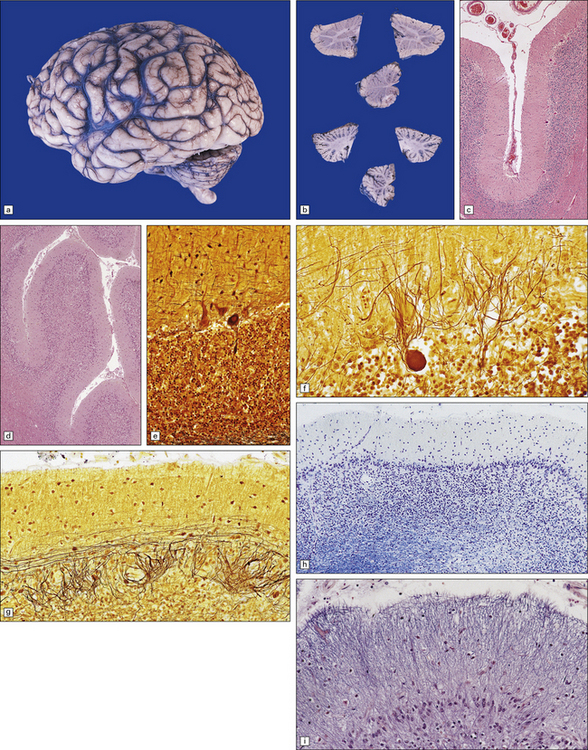
(a) Lateral view of the brain from a patient with pathology of a cerebellar cortical degeneration. Note the marked atrophy of the cerebellum in relation to the size of the cerebrum. (b) Slices through the cerebellar hemispheres and vermis of a control brain (top) and a patient with cerebellar cortical degeneration (bottom). Note the reduction in the volume of cortical gray matter and the widening of the cerebellar sulci in the patient’s cerebellum. (c) Patchy loss of Purkinje cells. (d) Severe diffuse loss of Purkinje cells. There is also marked depletion of granule cells and proliferation of Bergmann astrocytes. (e) The Purkinje cell axonal swellings are readily demonstrable by silver impregnation. (f) Note the ‘empty basket’ to the right of the axonal swelling. (g) Several adjacent ‘empty baskets’ in cerebellar cortical degeneration. (h) The degeneration of Purkinje cells is associated with proliferation of Bergmann astrocytes, at the junction of the granular and molecular layers. Note also the moderate loss of myelinated fibers from the white matter. (i) Bergmann astrocytosis accompanied by isomorphic gliosis of the molecular layer.
 Loss of neurons from the cerebellar cortex with associated tract degeneration associated with atrophy and neuronal loss from the inferior olivary nuclei (cerebello-olivary degeneration).
Loss of neurons from the cerebellar cortex with associated tract degeneration associated with atrophy and neuronal loss from the inferior olivary nuclei (cerebello-olivary degeneration).
 Loss of neurons from the cerebellar cortex, pontine nuclei and inferior olivary nuclei (olivopontocerebellar degeneration) (Fig. 29.2).
Loss of neurons from the cerebellar cortex, pontine nuclei and inferior olivary nuclei (olivopontocerebellar degeneration) (Fig. 29.2).
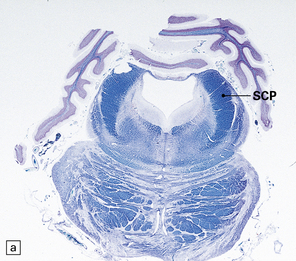
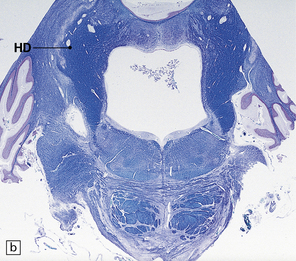
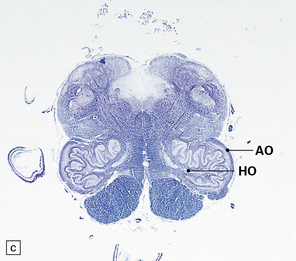
(a,b) This case shows degeneration of the pontine nuclei and transverse pontine fibers. (c) There is moderate depletion of neurons from the inferior olives, and loss of the corresponding afferent and efferent fibers from the amiculum (AO) and hilus (HO), which appear abnormally pale. The hilus of the dentate nucleus (HD) and the superior cerebellar peduncle (SCP) are relatively well preserved.
 Loss of myelinated axons from cerebellar afferent projections seen in the cerebellar peduncle, including loss of myelinated axons in tracts in the spinal cord (spinocerebellar degeneration)(Fig. 29.3).
Loss of myelinated axons from cerebellar afferent projections seen in the cerebellar peduncle, including loss of myelinated axons in tracts in the spinal cord (spinocerebellar degeneration)(Fig. 29.3).
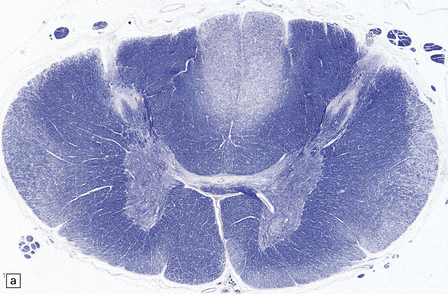
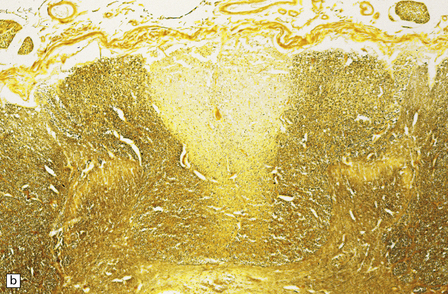
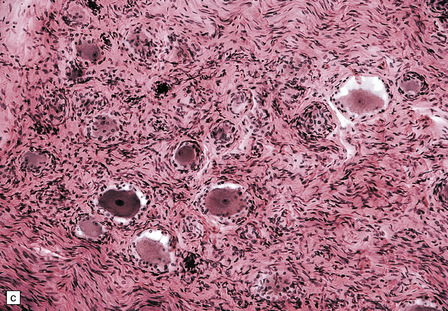
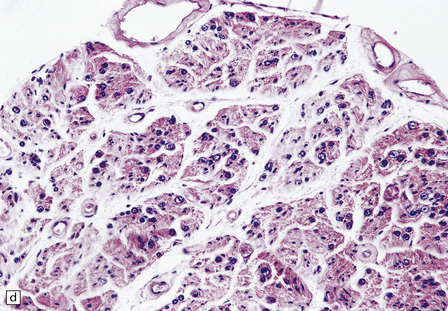
(a) There is degeneration of the gracile funiculi and spinocerebellar tracts in the upper cervical cord. As is often the case, at this level the pyramidal tracts are relatively spared. (b) Degeneration of the gracile funiculi. (c) Dense clusters of satellite cells (nodules of Nageotte) mark the sites where dorsal ganglion cells have degenerated. Satellite cells have proliferated to a varying extent around several of the remaining ganglion cells. (d) Marked loss of nerve fibers from a posterior lumbar nerve root.
 ± Loss of neurons from cerebellar dentate nuclei, cranial nerve nuclei, basal ganglia, substantia nigra, or red nucleus.
± Loss of neurons from cerebellar dentate nuclei, cranial nerve nuclei, basal ganglia, substantia nigra, or red nucleus.
CEREBELLAR CORTICAL DEGENERATION
OLIVOPONTOCEREBELLAR ATROPHY (OPCA)
AUTOSOMAL RECESSIVE CEREBELLAR ATAXIA
FRIEDREICH’S ATAXIA (FA)
 The spinal cord shows degeneration and astrocytosis of the posterior columns, affecting the gracile more than the cuneate fasciculus, with distal degeneration of the pyramidal and spinocerebellar tracts (Fig. 29.3a,b). There is typically severe loss of neurons from Clarke’s column.
The spinal cord shows degeneration and astrocytosis of the posterior columns, affecting the gracile more than the cuneate fasciculus, with distal degeneration of the pyramidal and spinocerebellar tracts (Fig. 29.3a,b). There is typically severe loss of neurons from Clarke’s column.
 In the medulla, tract degeneration is accompanied by neuronal loss from the accessory cuneate and gracile nuclei, reflecting transneuronal degeneration. Cell loss and astrocytosis are seen in the vestibular and cochlear nuclei and in the superior olives. The inferior olives are generally normal.
In the medulla, tract degeneration is accompanied by neuronal loss from the accessory cuneate and gracile nuclei, reflecting transneuronal degeneration. Cell loss and astrocytosis are seen in the vestibular and cochlear nuclei and in the superior olives. The inferior olives are generally normal.
 In the cerebellum, the white matter may show astrocytic gliosis but the cerebellar cortex is usually normal. Hypoxic–ischemic damage caused by cardiomyopathy may produce secondary cerebellar cortical damage. Severe cell loss is seen in the dentate nuclei and is associated with marked atrophy of the superior cerebellar peduncle.
In the cerebellum, the white matter may show astrocytic gliosis but the cerebellar cortex is usually normal. Hypoxic–ischemic damage caused by cardiomyopathy may produce secondary cerebellar cortical damage. Severe cell loss is seen in the dentate nuclei and is associated with marked atrophy of the superior cerebellar peduncle.
 In the cerebral cortex there are generally no specific pathologic changes, but functional imaging studies have demonstrated cortical atrophy and reduced metabolism. Hypoxic–ischemic damage due to cardiomyopathy may produce secondary cortical damage.
In the cerebral cortex there are generally no specific pathologic changes, but functional imaging studies have demonstrated cortical atrophy and reduced metabolism. Hypoxic–ischemic damage due to cardiomyopathy may produce secondary cortical damage.
 There may be neuronal loss from the globus pallidus and the subthalamic nuclei.
There may be neuronal loss from the globus pallidus and the subthalamic nuclei.
 Optic nerves and tracts usually show a slight loss of fibers.
Optic nerves and tracts usually show a slight loss of fibers.
 Peripheral nerves show a loss of dorsal root ganglion cells (Fig. 29.3c) associated with severe depletion of large myelinated axons from the posterior roots (Fig. 29.3d) and sensory nerves.
Peripheral nerves show a loss of dorsal root ganglion cells (Fig. 29.3c) associated with severe depletion of large myelinated axons from the posterior roots (Fig. 29.3d) and sensory nerves.![]()
Stay updated, free articles. Join our Telegram channel

Full access? Get Clinical Tree


Ataxic disorders
Only gold members can continue reading. Log In or Register to continue




